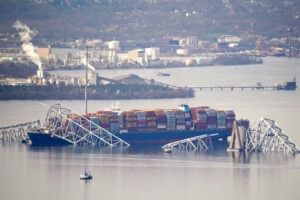This post originally appeared on Murder Is Everywhere.

Like so many Baltimoreans, I spent yesterday on the phone telling friends and relatives that I was alive. No, I hadn’t been anywhere near the Francis Scott Key Bridge early Tuesday morning. But I was following the news from before sunrise, because my email carried an emergency bulletin from the city. A bridge had collapsed—not just any bridge, but one bearing the name of The Star Spangled Banner’s author—a man who had witnessed the British attack on the Baltimore Harbor during the War of 1812 and written the song in honor of the defending Americans at Fort McHenry.
One of the first matters raised in the press and private conversation was whether this shocking collision had been an attack. A falling bridge reminded me of falling towers. And ships are supposed to be protected with backup systems should power be lost—so what happened?
The Dali, a cargo ship carrying containers bound for Sri Lanka, reportedly had its lights flicker off before they came back on, leading to speculation that a generator did kick in. Still, the crew realized they could not control the ship’s propulsion and issued a May Day signal. Fortunately, the alert was received and communicated instantly by the Maryland Department of Transportation. Police closed vehicle entry to the bridge just before the Dali hit one of the bridge’s major supports.
That was too late for a small group of construction workers atop the bridge, because after the collision, the bridge collapsed in forty seconds. Two men were rescued from the water, and the Coast Guard has announced that it’s unlikely the remaining six workers could have survived the cold waters this long. Of course, some cars might have already been on the bridge when it was closed; so there may be more cars and bodies submerged in the water.
According to a colleague who knew the crew, they were immigrants from El Salvador, Mexico, Honduras, and Guatemala. The workers were employed by a Baltimore County contractor who supplied labor for bridge repair and construction. Baltimore is the country’s largest point of entry for foreign cars, and overall, its third largest industrial port. And it’s one of the nation’s oldest ports, dating from the beginning of the 17th century, when tobacco was the chief imported product. The early locations were Fells Point, a beautifully preserved waterfront district, and then and Inner Harbor that edges our downtown area. The original owners of the 1897 house I live in had a saloon on Water Street near that harbor, which was a bustling, rowdy locale. As decades passed, more areas to receive cargo were built further out from the city itself. The northwest areas of the Patapsco River are the location of side of the Helen Delich Bentley Port of Baltimore, the chief industrial port.
The Dali was built by Hyundai in South Korea in 2016. After the Dali had an accident involving propulsion at the Antwerp, Belgium Harbor, its first owner sold it to a Singapore company, Grace Ocean Pte Limited. The ship’s technical state was managed by a company called Synergy that reportedly has a history of three worker deaths on their vessels since 2018. The 22 crew members of the Dali are Indian, and they are still on the boat, along with many of the 4600 20-foot containers of cargo. It seems miraculous that the whole crew survived the bridge collapse.
Civil engineers, boat experts, and veteran seafarers will be busy explaining the cause of the accident—ship company, bridge design, and perhaps something else—for months to come.
Yet I imagine that the construction workers on the bridge were in the wrong place at the wrong time only because they’d had to leave dangerous homelands. Upon arrival in Baltimore, they found jobs that ensured American comfort: raking leaves, cleaning bathrooms, digging up and repaving roads. For the Dali’s Indian crew, the motivation was likely similar. The promise of a decent paycheck sends many young Indians abroad to jobs where they work overly long hours under difficult conditions.
Until the bridge accident is cleaned up, Baltimore’s port will be closed to traffic. The cost of the lost business, and rebuilding the bridge, are huge; even if the latter is paid for by U.S. taxpayers and shipping insurance. But it’s also a very great cost to our humanity, if we forget that those most hurt by the bridge crash are the folks do the invisible work of making our life easier. And we will likely never know their names.
